
Kiewa Hydroelectric Scheme
Encyclopedia
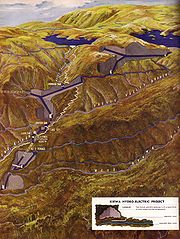
Victoria (Australia)
Victoria is the second most populous state in Australia. Geographically the smallest mainland state, Victoria is bordered by New South Wales, South Australia, and Tasmania on Boundary Islet to the north, west and south respectively....
and the second largest in mainland Australia
Australia
Australia , officially the Commonwealth of Australia, is a country in the Southern Hemisphere comprising the mainland of the Australian continent, the island of Tasmania, and numerous smaller islands in the Indian and Pacific Oceans. It is the world's sixth-largest country by total area...
after the Snowy Mountains Scheme
Snowy Mountains Scheme
The Snowy Mountains scheme is a hydroelectricity and irrigation complex in south-east Australia. It consists of sixteen major dams; seven power stations; a pumping station; and 225 kilometres of tunnels, pipelines and aqueducts and was constructed between 1949 and 1974. The Chief engineer was Sir...
. The scheme is situated in the Australian Alps
Australian Alps
The Australian Alps are the highest mountain ranges of mainland Australia. They are located in southeastern Australia and straddle the Australian Capital Territory, south-eastern New South Wales and eastern Victoria...
in north-eastern Victoria about 200 km from Melbourne
Melbourne
Melbourne is the capital and most populous city in the state of Victoria, and the second most populous city in Australia. The Melbourne City Centre is the hub of the greater metropolitan area and the Census statistical division—of which "Melbourne" is the common name. As of June 2009, the greater...
and is wholly owned by AGL Energy
AGL Energy
AGL Energy is the largest Australian gas and electricity retailer, with over six million customers. It has large investments in the supply of gas and electricity, and has recently invested in sustainable energy businesses such as wind farms and a hydroelectric power station in Victoria’s High...
.
The scheme was originally constructed between 1938 and 1961 by the State Electricity Commission of Victoria
State Electricity Commission of Victoria
The State Electricity Commission of Victoria was a monopoly electricity generation, transmission and supply utility located in Victoria, Australia...
although it was privatised in the 1990s. The scheme was originally developed solely for electricity generation
Electricity generation
Electricity generation is the process of generating electric energy from other forms of energy.The fundamental principles of electricity generation were discovered during the 1820s and early 1830s by the British scientist Michael Faraday...
, unlike the Snowy Mountains Scheme
Snowy Mountains Scheme
The Snowy Mountains scheme is a hydroelectricity and irrigation complex in south-east Australia. It consists of sixteen major dams; seven power stations; a pumping station; and 225 kilometres of tunnels, pipelines and aqueducts and was constructed between 1949 and 1974. The Chief engineer was Sir...
, which was also intended to direct water west of the Snowy Mountains for purposes of irrigation.
Inception
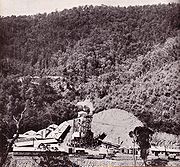
Mount Bogong
Mount Bogong , located in the Alpine National Park, is the highest mountain in Victoria, Australia. The Big River separates the massif of the mountain from the Bogong High Plains to the south. "Bogong" in the local Aboriginal language means bigfella...
- Feathertop
Mount Feathertop
Mount Feathertop is the second-highest mountain in the Australian state of Victoria and is a member of the Australian Alps located entirely within the Alpine National Park. It rises to and is usually covered in snow from June to September...
- Hotham
Mount Hotham
Mount Hotham is a mountain in Victoria, Australia. It is home to Hotham Alpine Resort. The mountain is located approximately north east of Melbourne, from Sydney, and from Adelaide by road. Mt Hotham's summit rises to an altitude of above sea level...
area was first proposed by a private company known as the Victorian Hydro-Electric Company (VHEC), established in 1911. The Kiewa River
Kiewa River
The Kiewa River is a major tributary of the Murray River in Australia.The river's headwaters include Victoria's highest mountain, Mount Bogong, and wind their way north-west about 100 kilometres, gradually slowing before joining the Murray east of Albury....
was the most desirable location for power generation.
In 1918 the Electricity Commissioners (later the State Electricity Commission of Victoria
State Electricity Commission of Victoria
The State Electricity Commission of Victoria was a monopoly electricity generation, transmission and supply utility located in Victoria, Australia...
were formed, and given a brief to investigate an alternate power generation scheme to the burning of brown coal from the Latrobe Valley
Latrobe Valley
The Latrobe Valley is an inland geographical region and urban area of Gippsland in the state of Victoria, Australia. It is east of the City Of Melbourne and nestled between the Strzelecki Ranges to the south and the Great Dividing Range to the north – with the highest peak to the north of the...
. In 1919 thee Commissioners opposed the VHEC being allowed to generate power in the Upper Kiewa, but a Victorian Government found that the Kiewa scheme would produce 30 megawatts of power at a capital cost of $8 million, cheaper than burning brown coal, but more energy than Melbourne
Melbourne
Melbourne is the capital and most populous city in the state of Victoria, and the second most populous city in Australia. The Melbourne City Centre is the hub of the greater metropolitan area and the Census statistical division—of which "Melbourne" is the common name. As of June 2009, the greater...
could then consume and at a capital cost twice as much.
The SECV was formed on 10 January 1921, and allocated $2.86 million for power generation works at Yallourn
Yallourn, Victoria
Yallourn, Victoria was a company town in Victoria, Australia built between the 1920s and 1950s to house employees of the State Electricity Commission of Victoria, who operated the nearby Yallourn Power Station complex. However, expansion of the adjacent open-cut brown coal mine led to the closure...
. The SECV bought out the VHEC soon after, and in 1923 a series of technical investigations undertaken into characteristics of rain and snowfall in the Australian Alps
Australian Alps
The Australian Alps are the highest mountain ranges of mainland Australia. They are located in southeastern Australia and straddle the Australian Capital Territory, south-eastern New South Wales and eastern Victoria...
. It was found that local snow was more dense and soggier than that in Europe, and formed weighty blocks, but no further works were carried out by the SECV.
Work begins
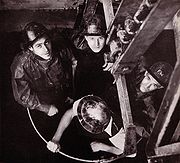
Bright, Victoria
Bright is a small sized town, located in northeastern Victoria, Australia, 319 metres above sea level at the southeastern end of the Ovens Valley. At the 2006 census, Bright had a population of 2684. It is in the Alpine Shire local government area...
, then by road via Tawonga Gap.
World War II
World War II
World War II, or the Second World War , was a global conflict lasting from 1939 to 1945, involving most of the world's nations—including all of the great powers—eventually forming two opposing military alliances: the Allies and the Axis...
intervened, and drained men and materials from the scheme, and by 1940 there was little chance of the scheme operating by the planned date of winter 1942. Work was 12 months behind, and work was changed to focus on Clover Power Station (Number 3), work on the rest of the scheme being stopped in February 1942. It was not until 1943 that the associated Junction Dam was completed, the power station not producing power until 1944.
By 1945 only a small part of the scheme was complete, and power demand had risen during war. The SECV re-examined the scheme from 1947, and in 1948 an augmented program of work was approved. The size of the main reservoirs was expanded, and the catchment area was increased though the use of open aqueducts. Generation capacity was also increased, with a maximum output of 289 megawatts, double that of the 1937 scheme. The cost was to be $50.4 million or 25.27 million pounds, and the generators would be located in a series of underground power stations, the first such installations in Australia. The town of Bogong was too restricted as a base camp, and the town of Mount Beauty
Mount Beauty, Victoria
Mount Beauty is a town in Victoria, Australia. It is in the Alpine Shire local government area.The town was originally established by the State Electricity Commission of Victoria to house construction workers from the Kiewa Hydroelectric Scheme in 1949, passing to the control of the local shire...
was established at the foot of the mountains. The railhead for materials was moved to Bandiana
Bandiana, Victoria
Bandiana is a bounded rural locality of the City of Wodonga Local Government Area in northeast Victoria, Australia. At the 2006 census, Bandiana and had a population of 114, mainly based at the military camp.-References:...
, and the Kiewa Valley Highway
Kiewa Valley Highway
Kiewa Valley Highway traverses alpine regions of Victoria, Australia for a distance of . In the 1950s the road was sealed and realigned to Mount Beauty to permit the transport of materials for the construction of the Kiewa Hydroelectric Scheme...
was sealed and realigned for 50 miles (80.5 km) to Mount Beauty.
With fears of new World War and a huge demand for electric power, by June 1951 works had reached full momentum, and the anticipated commissioning date of 1956 was considered achievable. 4000 men were employed on the project, and works on went ahead with as much haste as funds could muster. Some in the SECV believed an equivalent quantity of power could be generated from other sources cheaper, but abandonment was impossible in light of the need for additional capacity quickly.
Scaled back
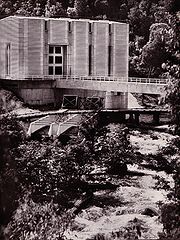
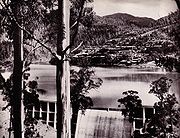
As the recession continued, then Prime Minister
Prime Minister of Australia
The Prime Minister of the Commonwealth of Australia is the highest minister of the Crown, leader of the Cabinet and Head of Her Majesty's Australian Government, holding office on commission from the Governor-General of Australia. The office of Prime Minister is, in practice, the most powerful...
Robert Menzies
Robert Menzies
Sir Robert Gordon Menzies, , Australian politician, was the 12th and longest-serving Prime Minister of Australia....
was forced to cut spending on capital works. The Snowy Mountains Scheme
Snowy Mountains Scheme
The Snowy Mountains scheme is a hydroelectricity and irrigation complex in south-east Australia. It consists of sixteen major dams; seven power stations; a pumping station; and 225 kilometres of tunnels, pipelines and aqueducts and was constructed between 1949 and 1974. The Chief engineer was Sir...
, commenced in 1949 by the Commonwealth Government, was a source of national prestige and political advantage, and so the cuts were made to state government projects. Commonwealth loan funds were cut off to the Kiewa Scheme, and power from the Snowy Mountains Scheme would be provided to Victoria to fill the gap. Employment on Kiewa dwindled to 1000 men.
The Scheme was scaled back, with the major reservoir at Pretty Valley reduced to a minor diversion weir, and Number 5 Power Station in the West Kiewa Valley was abandoned.
By 1955 the West Kiewa Power Station (Number 4) commenced operation, in 1959 the Rocky Valley Dam
Rocky Valley Dam
The Rocky Valley Dam is located on the Bogong High Plains, near Falls Creek, Victoria, a winter ski resort. The dam is man-made and has a capacity of 28 000 megalitres and is situated at 1600 metres above sea level....
was almost complete, and in 1960 the McKay Creek Power Station (Number 1) was commissioned, completing the scheme with 184 megawatts of generation capacity.
In 1957, the SECV publicly announced that the scheme should not be completed as originally proposed, and did not move to expand it for a decade afterwards, but still privately maintained that the scheme has never been finished.
Privatisation
With the privatisation of the State Electricity Commission of VictoriaState Electricity Commission of Victoria
The State Electricity Commission of Victoria was a monopoly electricity generation, transmission and supply utility located in Victoria, Australia...
in the 1990s, the scheme passed to Southern Hydro, then acquired by AGL Energy
AGL Energy
AGL Energy is the largest Australian gas and electricity retailer, with over six million customers. It has large investments in the supply of gas and electricity, and has recently invested in sustainable energy businesses such as wind farms and a hydroelectric power station in Victoria’s High...
in 2005.
AGL constructed the originally planned Bogong Power Station (Number 2), which was completed in November 2009 at a cost of $240 million. . The work consisted of 5.7 km of 5 metre diameter headrace
tunnel, two vertical shafts, a 1 km steel-lined high pressure tunnel, a power station to house twin 70 MW generators and a tailrace outfall into neighbouring Lake Guy.
The original Number 2 power station was to involve a dam below McKay Creek power station, and a surface power station of 95 MW capacity. However due to environmental concerns the design was altered so that the McKay discharge would feed into the Bogong tunnel, leaving the river between them to run naturally.
The West Kiewa Power station is also being upgraded to a capacity of 74 MW.
Components
The main reservoir of the scheme is the Rocky Valley DamRocky Valley Dam
The Rocky Valley Dam is located on the Bogong High Plains, near Falls Creek, Victoria, a winter ski resort. The dam is man-made and has a capacity of 28 000 megalitres and is situated at 1600 metres above sea level....
, which has a capacity of 28 billion litres and is situated at 1600 metres above sea level. The scheme also contains a number of smaller dams and pondage
Pondage
Pondage usually refers to the comparably small water storage behind the weir of a run-of-the-river hydroelectric power plant. It is considerably less storage than the reservoirs of large dams and conventional hydroelectric stations which can store water for long periods such as a dry season or year...
s. A great deal of the water in the dams comes from melting snow, which covers much of the area during cooler months.
Linking the reservoirs and power station are 11 miles (17.7 km) of tunnels, and 32 km of aqueducts. The scheme consists of four power stations:
| No | Power station | Max. Capacity Electric power Electric power is the rate at which electric energy is transferred by an electric circuit. The SI unit of power is the watt.-Circuits:Electric power, like mechanical power, is represented by the letter P in electrical equations... |
Turbines Water turbine A water turbine is a rotary engine that takes energy from moving water.Water turbines were developed in the 19th century and were widely used for industrial power prior to electrical grids. Now they are mostly used for electric power generation. They harness a clean and renewable energy... |
Coordinates |
|---|---|---|---|---|
| 1 | McKay Creek Power Station McKay Creek Power Station McKay Creek Power Station is one of four hydroelectric power stations in the Kiewa Hydroelectric Scheme, Victoria, Australia. McKay Creek has six 25 MW generators driven by Pelton wheel turbines, with a total generating capacity of 150MW.... |
150 MW | 6 | 36°51′31"S 147°14′3"E |
| 2 | Bogong Power Station | 140MW | 2 | 36°48′23"S 147°13′40"E |
| 3 | Clover Power Station | 29 MW | 2 | 36°47′8"S 147°13′14"E |
| 4 | West Kiewa Power Station | 62 MW | 4 | 36°45′36"S 147°11′10"E |
| Component | Location | Notes |
|---|---|---|
| Rocky Valley Dam | 36°52′27"S 147°17′38"E | |
| Rocky Valley Aqueduct | 36°52′6"S 147°17′42"E | Diverts water south into Rocky Valley Dam |
| Langford West Aqueduct | 36°53′38"S 147°18′59"E | Diverts water north into Rocky Valley Dam from vivinity of Mt Cope |
| Langford East Aqueduct | 36°52′51"S 147°20′16"E | Diverts water east into Rocky Valley Dam |
| Pretty Valley Pondage | 36°53′56"S 147°14′19"E | Pondage for McKay Creek Power Station. Fed by tunnel from Rocky Valley Dam |
| Cope East Aqueduct | 36°55′57"S 147°16′8"E | Diverts water north through Cope Saddle into Pretty Valley Pondage |
| Cope West Aqueduct | 36°56′3"S 147°15′7"E | Diverts water north through Cope Saddle into Pretty Valley Pondage |
| McKay Creek Power Station penstock | 36°51′53"S 147°14′13"E | Carries water from Pretty Valley Pondage to McKay Creek Power Station. |
| Lake Guy | 36°48′0"S 147°13′27"E | Pondage for Clover Power Station. |
| Clover Dam | 36°46′52"S 147°13′7"E | Pondage for West Kiewa Power Station. |
| West Kiewa Power Station tailrace | 36°44′40"S 147°10′4"E | |
| Mt Beauty Pondage | 36°46′52"S 147°13′7"E | Regulation pondage below West Kiewa Power station |
Gallery
Image:Kiewa power station 3 diagram.jpg|Internal diagram of Clover Power Station (Number 3)
Image:Kiewa power station 3 generator floor 13000kw.jpg|13,000 kW generators
Image:Kiewa power station 3 turbine floor 16000hp.jpg|16,000 HP turbines

